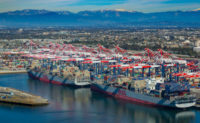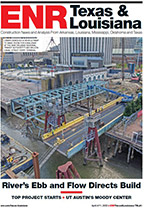Transportation
Canal Authority's Arias In an Expansive Mood
Photo by C.J. Schexnayder/ENR
Panama City, Panama – Agustin Arias is the Director of Engineering and Projects for the Panama Canal Authority (ACP). Since 2001 his primary responsibility has been overseeing the $5.25-billion expansion to the historic waterway.
He holds a mechanical and industrial engineer by training, he holds masters degrees from both the University of Missouri and the University of Miami. In his quarter-century working for the canal authority, Arias has been involved with evaluating many of the waterway’s improvement projects as well as the execution of the major capitol investment projects.
In March, ENR spoke with Arias about the origins of the expansion plan and the unique engineering challenges this massive project presents.
When did the plans to expand the canal begin?
There have been several initiatives to expand the canal over the years. The first one was, if I am not mistaken, in 1928. From that study (The US Army Corps of Engineers) initiated the expansion in 1939 and that’s when they began the actual construction of the third set of locks. But that was for military reasons, not commercial reasons. And when (World War II) came they suspended the effort and the funding went to other priorities. After that the canal lost a bit of strategic value in terms of the military. But there were studies done in 1947 in the late 1970s – and these are major feasibility studies – and other studies that were conducted in the early 90s and the effort we have now. The last two were examining the commercial aspects.
What started the ACP’s current expansion effort?
We began looking at issues that concern the expansion of the canal in 1998 starting with water resources. We had a severe El Nino in late 1997 and early 1998 that impacted the country’s water supply and there was a lot of concern if we were going to have sufficient water for the existing canal much less for the expansion. So we started looking at alternatives for new water sources and how to maximize the yield of the watershed. We conducted a very extensive study that evaluated more than 30 alternatives for the water supply and we developed numerous mathematical models to do simulation runs under different scenarios and different conditions and different configurations of the watershed.
What else affected the decision to move forward with the project?
 Arias
|
Around the year 2000 with a significant growth in the number of maximum sized panamax vessels that began to transit the canal. This was to several things like the increase in world trade. A lot of this was due to geopolitical changes like China’s economic expansion. The revolution of the container traffic began to accelerate as well. A lot of the cargo that was handled using other means started to containerize, like refrigerated goods. Refrigerated goods are handled in refrigerated containers rather than refrigerated ships. And we started seeing the impact of these various factors.
Why did you eventually choose the current plan over the other alternatives?
The main reason behind the expansion is the need for capacity. We had several options in terms of water use and we chose the ones that were most effective and most appropriate for the increase in capacity. When we say capacity, we charge by tonnage, we don’t charge on a per-transit basis. So once we made up our mind…when we identified we had a capacity problem we asked "how are we going to solve it?" And the answer is building a third lane that can handle the bigger container vessels the industry is moving toward using.
Why is the expansion so important for achieving that?
The existing locks have significant requirements for maintenance. If traffic continues to grow it is going to be very difficult to do maintenance without affecting the quality of service. We don’t have the buffer capacity we had before because traffic keeps on growing and growing and growing and growing. It won’t be long that if we had to shut down one of the lanes there would be huge backlogs and it will not only have an impact on the operations but the users will have to make a decision. With the new lane we should have enough capability to do the required maintenance and at the same time provide the same level of quality of service.
What makes this lock design so unique?
In terms of the locks, what we are recommending is proven technology that is in use elsewhere for more than a century. But no one has built locks of the size we are proposing. There are rolling gate locks in Europe but these are single-lift locks with low heads that are basically for barge traffic. We are proposing to build triple lift locks with high heads. There are locks with water saving basins in Germany but they are about one fourth the size of these or even less. Incorporating all those technologies proven somewhere else into a single project of the size we are proposing is the major challenge. There can be no benchmarking because there is no other lock with all these features.
What is the most important factor making a project of this scale possible?
You have to remember that we are trying to take advantage of as much of the infrastructure we have in the canal as we possibly can, which is the navigational channels. Seventy five percent of what we handle with the canal is navigation channels and we want to take advantage of what we have already in place. That means more deepening and widening but that’s also something that already exists and that’s the key to maintaining a reasonable price tag. If we had to build this from scratch, then it would be impossible to afford.
What is the most difficult aspect of the expansion effort?
The key is the synchronization of getting everything done on time. That’s going to be our biggest challenge. For example, the dry excavation we are going to split it into five contracts so there won’t be a single contractor handling all the dry excavation. With five contracts, if something goes wrong we can react much quicker and the impact is not going to be all that severe. So I think we are reducing the risk associated with the overall project by doing it this way. By subdividing the work to three components, we also minimize the risk because we don’t put everything on the shoulder of a single contractor or a single group.






